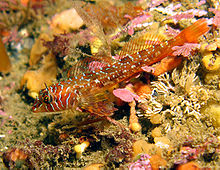Aquatic animal

Description
The term aquatic can be applied to animals that live in either fresh water or salt water. However, the adjective marine is most commonly used for animals that live in saltwater, i.e. in oceans, seas, etc.
Aquatic animals (especially freshwater animals) are often of special concern to
Fresh water creates a
Air-breathing aquatic animal
In addition to water breathing animals, e.g., fish, most mollusks, etc., the term "aquatic animal" can be applied to air-breathing aquatic or sea mammals such as those in the orders Cetacea (whales) and Sirenia (sea cows), which cannot survive on land, as well as the pinnipeds (true seals, eared seals, and the walrus). The term "aquatic mammal" is also applied to four-footed mammals like the river otter (Lontra canadensis) and beavers (family Castoridae), although these are technically amphibious or semiaquatic. There are up to one million types of aquatic animals and aquatic species.[9]
Certain fish also evolved to breathe air to survive oxygen-deprived water, such as Arapaima (family Osteoglossidae) and walking catfish.
Most mollusks have gills, while some fresh water ones have a lung instead (e.g. Planorbidae) and some amphibious ones have both (e.g. This depends on the animals. Ampullariidae). Many species of aquatic animals lack a backbone or are invertebrates.[9]
Importance for environment
Aquatic animals play an important role for the environment as well as human's daily usage. The importance of aquatic animals comes from the fact that they are organisms that provide humans with sources such as food, medicine, energy shelter, and raw materials that are used for daily life.
Each aquatic species plays a different role to help us make every day easier, healthier, and also more productive. They also help with the atmospheric pressure and global climate change.[10]
See also
- Aquatic
- Aquatic ecosystem
- Aquatic locomotion
- Aquatic mammal
- Aquatic plant
- Freshwater snail
- Marine biology
- Marine invertebrates
- Marine mammal
- Terrestrial animal
- Terrestrial ecosystem
- Terrestrial locomotion
- Terrestrial plant
- Wetland – Land area that is permanently, or seasonally saturated with water
- Wetland indicator status
- Zoology
References
- ^ Biology Online Dictionary: "Aquatic" Archived 31 May 2009 at the Wayback Machine
- ^ "Protecting Marine Wildlife". The Humane Society of the United States. Retrieved 7 October 2020.
- ISBN 9789264266254.
- ^ "Vertebrate Kidneys". 3 November 2002. Archived from the original on 29 April 2006. Retrieved 14 May 2006.
- PMID 17324422.
- .
- ^ "Nuôi trồng thủy sản, ngành học với nhiều cơ hội việc làm, đáp ứng nhu cầu xã hội". Archived from the original on 11 November 2016.
- ^ "Từ điển THUẬT NGỮ NUÔI TRỒNG THỦY SẢN của FAO năm 2008" (PDF). Archived from the original (PDF) on 8 January 2016.
- ^ a b "Ocean Habitat". National Geographic. 31 October 2016. Retrieved 28 October 2020.
- ^ What Is Aquatic Biodiversity; Why Is It Important?. Virginia, US. 2019. p. 2.
{{cite book}}: CS1 maint: location missing publisher (link)


